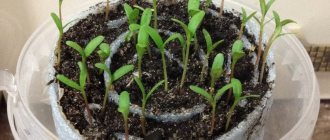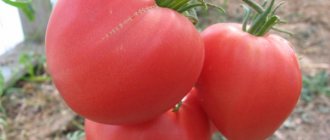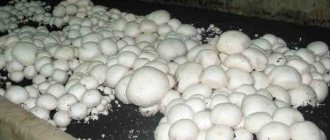Growing tomatoes in a polycarbonate greenhouse attracts many vegetable growers. Closed ground conditions require a more careful attitude to the plants, but give very interesting results. This method is especially in demand in regions with a cool climate and short summers, where growing a large crop of tomatoes is problematic.
Features of growing tomatoes in a polycarbonate greenhouse
To get a good result from planting tomatoes indoors, you need certain knowledge. Polycarbonate greenhouses have their own characteristics, advantages and disadvantages.
Therefore, methods for growing tomatoes in such a room vary significantly, depending on the agricultural technology of the open ground. We have to take into account:
- temperature changes during the day;
- the need to maintain a certain percentage of air humidity;
- the possibility of overheating of plants during the daytime;
- small area size;
- rapid spread of infection.
To achieve good tomato yields, it is important for farmers to choose the right varieties, carefully and competently prepare the greenhouse for planting, be able to prepare and disinfect the soil, and carry out preventive treatments on time.
Pros and cons of growing tomatoes in a polycarbonate greenhouse
For those who decide to plant tomatoes in a polycarbonate greenhouse, it is important to familiarize themselves with the advantages and disadvantages of this growing method. Having weighed all the nuances, it is easier to adjust the process. Among the advantages of closed soil for tomatoes, vegetable growers highlight:
- Earlier harvest. This is due to the fact that seedlings can be planted in a greenhouse earlier than outside.
- The ability to create stable conditions for tomatoes. Under the roof of a greenhouse, tomatoes are not afraid of heavy rain, hail, wind or scorching sun.
- Absence of many types of pests in the greenhouse area. The closed space does not allow parasites to enter the tomato beds.
- There is no need for frequent watering and fertilizing. The absence of wind helps retain moisture, and balanced conditions and optimal soil composition provide the tomatoes with adequate nutrition.
However, one cannot ignore the disadvantages of growing in polycarbonate-covered greenhouse areas. They are determined by the specifics of the material from which the premises are constructed:
- Difficulties in ventilation. Natural ventilation when covering a greenhouse with solid polycarbonate sheets is much lower than with “frame” or film sheets. Therefore, it is necessary to provide structures with side and top windows. The minimum quantity is 3 windows. If you install at least one with an automatic opening device when the temperature changes, this will significantly improve the condition of the tomatoes and increase the yield.
- Mandatory preventive treatments against late blight and pests. The proliferation of pathogenic microorganisms, fungi and parasites occurs in greenhouses as quickly as in the open air. Therefore, before planting tomatoes, the greenhouse is prepared by thoroughly disinfecting the structures.
- Use of the entire area for a specific crop. It is not recommended to plant cucumbers and tomatoes in the same greenhouse area. Tomatoes require different temperature and humidity parameters than cucumbers. As a result, the yield of one of the crops will be lower than expected.
- Lighting control. There is slight shading in the greenhouse due to the lower light transmitting ability of polycarbonate than glass. This affects the yield of tomatoes. If there are objects that cast a shadow, then they need to be eliminated or the tomato beds should be placed correctly.
Taking into account all the nuances, you can achieve high efficiency in growing tomatoes in a polycarbonate greenhouse.
Room ventilation and watering
When warm, sunny weather has settled outside the greenhouse, it is recommended to open the greenhouse to a quarter of the top on each end side. But keep in mind that tomatoes are afraid of drafts.
On warm days, it would be correct to completely open part of the greenhouse on the western side, thereby ensuring not only good ventilation, but also access for insects that pollinate the flowers. If insects do not enter the greenhouse, help the plant pollinate: shake it when flowering. To prevent pollen from scattering, moisten the paths after the procedure.
To ventilate the greenhouse, open doors and vents. Important! The main enemy of tomatoes is dampness. Do not forget to ventilate the greenhouse in a timely manner.
Immediately after planting the plant in the greenhouse, it is necessary to thoroughly water the bushes. Young plants also require frequent watering. Their still fragile roots are able to take water only from a shallow depth, so watering is carried out as the top layer of soil dries.
Some say that it is better to water tomatoes in the evening, others say that early watering has a better effect on growth, but in fact, daytime watering is the most correct. And all because to water tomatoes you need warmed water with a temperature not lower than the soil temperature.
The best way to water tomatoes is by drip.
It is not recommended to get water on the leaves of plants, so root watering is carried out. For watering, both a hose and a simple bucket with a ladle are suitable, but these two methods contribute to the formation of a crust on the soil. There is a need for frequent loosening. Therefore, the most optimal is drip irrigation. With drip irrigation, physical labor is eliminated, crusts do not form on the top layer of soil, and there is no unnecessary evaporation that increases the humidity in the greenhouse. This type of watering prevents the soil from drying out or becoming waterlogged.
The best varieties of tomatoes for growing in a greenhouse
The result directly depends on the choice of variety. There are types of tomatoes intended for growing in greenhouse areas. They give a guaranteed harvest in closed ground conditions. Some varieties are considered universal; they are equally successfully grown in open beds and in greenhouses. The main difference between varieties that must be taken into account when choosing a variety relates to the type of bush:
- Indeterminate plants give a good harvest due to the ability to tie 6-7 clusters to the trellis. If such varieties are not formed, they will create greater thickening. They are considered priority species for polycarbonate greenhouses due to earlier ripening and duration of fruiting.
- Determinate ones are limited in growth. But when the bushes develop, there will be enough light and air in the greenhouse area.
Many vegetable growers prefer mixed plantings for indoor soil. They believe that planting determinate varieties along the walls allows for more efficient use of greenhouse space. It is best to buy hybrid seeds for indoor soil.
On the modern market there is a sufficient selection of tomato varieties for greenhouse cultivation. It is better for beginners to start with time-tested types; experienced professionals can experiment a lot. Among the noteworthy varieties it is worth noting:
- Southern tan. A variety of yellow tomatoes with an original fruit shape. The large-fruited tall species (indeterminate) is suitable for greenhouse cultivation and in open beds. Medium ripening period, excellent taste. It produces greater yields in greenhouses, as it requires heat.
- Honey Spas. Salad indeterminate variety of yellow tomatoes. The large, heart-shaped fruits ripen 110 days after planting. It requires the formation of a bush of 2-3 stems per 1 square meter. m of polycarbonate greenhouse area no more than 4-5 bushes are placed.
- Eleanor. Determinate red-fruited tomato of mid-season variety. The fruits are small and are used fresh or canned. It prefers warmth, so it bears fruit well in closed ground conditions.
- Cardinal is an elegant raspberry-pink variety of tomatoes for a polycarbonate greenhouse. Indeterminate, mid-early, very tasty. Formed into 1-2 stems, the bushes need a garter. Productive - up to 14 kg per 1 sq. m, disease resistant.
Many vegetable growers prefer small-fruited cherry tomato varieties. They are planted in the same area with high indeterminate varieties. Suitable for a polycarbonate greenhouse:
- Bonsai. Determinate variety, bush height is about 50 cm. It forms independently as a standard. The taste of the tomato is excellent, the weight of the fruit does not exceed 30 g. 1 kg of fruit is collected from one plant.
- Minibel. The fruits are small, but very tasty. Bushes are decorative and productive. Plant height is about 40 cm, ripening period is 90 days.
Of course, dwarf varieties are not a priority, but in a greenhouse they give a good harvest and serve as a worthy decoration.
In addition to the listed varieties, the hybrids “Bourgeois”, “Sprut”, “Azhur”, and “Major” are very popular. The alphanumeric index F1 guarantees good fruiting and disease resistance. Self-pollinating hybrids do not require artificial pollination. This is an ideal option for a polycarbonate greenhouse.
Greenhouse preparation
The grown seedlings are planted in the greenhouse on May 1–10. During this period it is still cool, especially at night, so it is recommended to cover the greenhouse with two layers of film, the distance between the films should be 2–3 cm. This coating not only improves the thermal regime, but also increases the service life of the lower film until late autumn. The second layer of film is removed June 1–5. A greenhouse intended for tomatoes should have vents not only on both sides, but also on the top (1–2), since tomatoes, especially during flowering, need careful ventilation.
To avoid diseases, it is not recommended to plant tomatoes in one greenhouse for several years in a row. Usually they are alternated with cucumbers, that is, one season - cucumbers, the second - tomatoes. But recently, cucumbers and tomatoes have begun to suffer from the same fungal disease - anthracnose (root rot). Therefore, if tomatoes are still planted after cucumbers, then it is necessary to remove all the soil from the greenhouse or at least remove its top layer of 10–12 cm, where all the infection is located. After this, the soil must be sprinkled with a hot (100°C) solution of copper sulfate (1 tablespoon per 10 liters of water) or two tablets of OXYCHOM.
If there is only one greenhouse, then it is partitioned in the middle with film, growing cucumbers on one side and tomatoes on the other. Tomatoes and cucumbers are not grown in the same greenhouse, since tomatoes require more ventilation, lower humidity and air temperature compared to cucumbers. The greenhouse should be fully illuminated by sunlight from morning to evening; even slight shading by trees or bushes entails a decrease in yield. The ridges are made along the greenhouse, their number depends on its width. The beds are made 8–10 days before planting the seedlings, 35–40 cm high, the width of the bed depends on the greenhouse (usually 60–90 cm), and a passage of at least 60–70 cm is made between the beds.
Growing tomato seedlings for planting in a greenhouse
Growing seedlings yourself has several advantages:
- The vegetable grower knows exactly what variety of tomatoes he has sown.
- The owner of a greenhouse can be confident in the exact observance of sowing dates and the quality of pre-planting preparation of seeds, containers, and soil.
- It is easy to ensure control of all necessary activities for growing healthy tomato seedlings.
The entire process of preparing seedlings for transplanting into a polycarbonate greenhouse looks like this:
- Choice of variety. It is necessary to select tomato hybrids that meet all the needs of the vegetable grower. Carefully familiarize yourself with the requirements of the species, its adaptability to the conditions of a polycarbonate greenhouse, and the main characteristics.
- Prepare planting material for sowing. If the seeds are not processed by the manufacturer, you will need to place them in a saline solution (5%) for 7-10 minutes to select suitable ones. Then rinse and leave on a damp cloth to germinate. It is recommended to treat tomato seeds with a weak fungicide solution to prevent possible infectious contamination of seedlings.
- Prepare containers and soil. The container is chosen depending on the possibilities. If you have a lot of space to grow tomato seedlings, you can take separate containers, cups or pots. With a minimum area, a common planting box that can be easily installed on a windowsill will be more effective. Containers for sowing tomato seeds must be disinfected, and plastic containers must be washed well. The soil is taken ready for tomato seedlings. It is easy to purchase at garden stores. It contains all the necessary components and substances that tomato seedlings will need during the first period of development. Important! For tomato seedlings, use containers with drainage holes.
- Sow tomato seeds. To do this, you need to fill the container with soil mixture, shaking it periodically. Then spread the tomato seeds over the surface, sprinkle with a 1 cm thick layer of soil, and spray with water from a spray bottle.
- Provide a greenhouse effect. Cover the container with glass, film or place in a bag. Place in a warm place.
Having created ideal conditions for tomato seedlings, all that remains is to ventilate the greenhouse and spray the soil with water once every 3 days.
As soon as the seedlings appear, the seedlings should be moved to a lighted place and continued care. It is important that tomato seedlings do not stretch. To do this they need enough light. Watering no more than 2-3 times a week - seedlings do not like waterlogging. Water for irrigation should be at room temperature (20 °C). At night the air temperature is maintained within + 13-15 °C, during the day + 18-20 °C. Turn the container to the light in different directions every day. This technique saves you from pulling out tomato seedlings. Picking is done in the phase of 2 true leaves. Continue watering once a week. 14 days after picking, feed the plants with nitrophoska (1 tbsp per bucket of water). Repeat feeding after 14 days. For one tomato bush, 1 cup of solution is enough. A week before planting in the greenhouse, spray the seedlings with a solution of boric acid (1%). This will preserve all the flower buds.
Properly planting tomato seedlings
Unovergrown seedlings (25–35 cm) are planted vertically , filling only the pot with soil mixture. Even if the seedlings have stretched out for some reason, it is not recommended to bury the stem when planting . The stem covered with soil mixture immediately produces additional roots. This stops the growth of the plant and causes the flowers to fall off from the first cluster. Therefore, if the seedlings are overgrown, then I advise you to plant them as follows. Make a wide hole 12 cm deep, in it there is a second hole deeper to the height of the pot, place a pot of seedlings in it and fill the second hole with soil. The first hole remains open for now. After 12 days, as soon as the seedlings have taken root well, fill the hole with soil.
Hybrids and varieties of tall plants are planted in the middle of the bed in one row or in a checkerboard pattern 50–60 cm apart.
Agricultural technology for growing tomatoes in a polycarbonate greenhouse
Vegetable growers should know that tomato seedlings with certain parameters are suitable for planting. Before planting, they should have a height of 35 cm, 8-12 true leaves, 1-2 inflorescences. Before planting in a polycarbonate greenhouse, it is better to cut off 2-3 lower leaves to improve ventilation and reduce the risk of disease. The optimal age of seedlings is no more than 60 days. Polycarbonate will protect tomatoes from possible fluctuations in ambient temperature.
The technology for growing tomatoes in a polycarbonate greenhouse provides for the presence of a sufficient amount of calcium, which prevents the falling of flowers and the development of fruit diseases. Also necessary are substances from the NPK group, microelements in an accessible form for absorption by tomatoes.
Landing dates
The planting time is calculated based on the life expectancy of tomatoes in a polycarbonate greenhouse. Typically, vegetable growers plan to transplant seedlings in early May, when the ground warms up enough. This is enough time for the tomatoes to form 7-8 bunches during the season. Approximate dates:
- late-ripening, mid-ripening varieties and tall hybrids - from May 1 to May 10;
- early ripening - from April 15 to 25.
The exact date can be checked with the lunar calendar recommendations for the corresponding region.
Soil preparation
It is very important to properly prepare the soil. If you prepare a soil mixture for tomatoes yourself, then most often vegetable growers use soil from their own plot.
Loamy or clayey soil needs to be structured. It is enough to contribute per 1 sq. m area of peat, sawdust and humus, one bucket of each component. For peaty soil, add turf soil, wood shavings (fine), humus - 1 bucket per 1 square meter. m and 0.5 buckets of coarse sand. For chernozem, 1 bucket of humus and 0.5 buckets of sand are enough. Additionally you need to pay per 1 sq. m greenhouse area:
- 1 tsp. ammonium nitrate;
- 3 tsp. superphosphate;
- 2 tbsp. l. wood ash.
Dig up the resulting composition and loosen it.
Growing tomatoes in a polycarbonate greenhouse requires compliance with certain rules. Before the formation of ridges, the soil must be removed, treated with disinfecting solutions, fertilized and only then laid. Restoring fertility after harvesting is a mandatory condition of agricultural technology.
Landing rules
The basic rules are to follow the planting pattern and correctly transplant tomato seedlings. The scheme depends on the variety and development characteristics of the tomato bush. There are recommendations for this:
- Low-growing, early-ripening species form 3 shoots. Therefore, it is customary to plant them in two rows in a checkerboard pattern. The distance between bushes is 35 cm.
- Standard trees are allowed to be planted thicker. They develop one main shoot, so leave no more than 30 cm between tomatoes.
- Tall plants are placed at a distance of 70 cm from each other and also in the form of a chessboard.
Important! Tomatoes cannot be planted in a polycarbonate greenhouse for 2 years in a row in the same soil and in the same place.
Tomato care
To get a good harvest of tomatoes in a polycarbonate greenhouse, you need to strictly follow the rules for growing and caring for plants. Vegetable growers pay their main attention to those activities that have a direct impact on the development of the bush and the formation of fruits. Each procedure has its own nuances due to the specifics of the covering material.
In a polycarbonate greenhouse, tomatoes need:
- Watering. Infrequent, but plentiful. The bushes are watered for the first time 7-10 days after planting. During this time, the plants will have time to “take root.” Then follow the schedule 1-2 times during the week, but taking into account soil moisture and ambient air.
- Ventilation, shading. If you allow high humidity and high temperatures, then indoors tomatoes begin to be affected by late blight or brown spot. Therefore, it is impossible to do without regular ventilation. Open transoms in the morning and close them in the evening. This will save the tomatoes from fog. In extreme heat, it is recommended to additionally shade the plantings with thin covering material, gauze, and paper.
- Stepsonning. This technique is necessary for tomato varieties that need to remove shoots. Remove them regularly, pinching them when they are no more than 5 cm in size. At the same time, leave stumps 2 cm high to prevent re-growth. The second aspect is to remove the lower leaves up to the first cluster.
- Feeding. When growing in greenhouses, regular feeding is required. Organic and mineral complexes are used. There are types of tomatoes with intensive fruiting; they need to be provided with a full list of macro- and microelements. The first fertilizing can be done with organic matter 10 days after planting. “Green fertilizer” is suitable - an infusion of herbs. For 200 liters of water you will need 2 buckets of chopped grass (nettle, wheatgrass, wood lice). Add 0.5 buckets of ash, 1 bucket of manure. Infuse the mixture for 12 days, then dilute with water (1:10). Tomatoes are fertilized using the root method at the rate of 1 bucket per 1 square meter. m area. You can replace organic fertilizer with the ready-made composition “Fertility”. Use 3 times per season, mixing 10 liters of water, 1 tbsp. l. means, 1 tsp. potassium sulfate. Foliar sprays are very important for greenhouse cultivation. Vegetable growers use iodine (3 drops per 1 liter of water), boric acid (1%), superphosphate, potassium and calcium nitrate (according to instructions). You can use special complexes (“Ovary”).
- Tying. For this, trellises or individual supports are used. In addition to the stems, heavy brushes should be tied up.
Video about growing tomatoes in a polycarbonate greenhouse:
Growing tomatoes
Often gardeners have to speed up the process of fruit ripening. This is especially true for regions with a short warm period. Planting tomatoes will help with this.
Pinching is the process of removing all unnecessary side shoots from a bush. This procedure is extremely important for the rapid ripening of fruits: thanks to the removal of stepsons, the plant will direct all nutrients to the ripening of the fruits, and not to the development of the stem. In addition, pinching tomatoes reduces the likelihood of bushes being affected by late blight.
The first time tomatoes are planted after two weeks of growing seedlings in the garden, after that - every 12 days. Tall bushes usually form several (2-3) stems. At the same time, 5-7 flower brushes are left on each stem.
Plants should be trimmed in the morning so that the cuttings have time to last until nightfall. When growing tomatoes in rainy weather, the cuts should be treated with ash. Shoots must be removed in such a way that they leave stumps of 15-30 mm. At the same time, not only stem shoots are sprouted, but also root shoots.
Topping the plant and removing excess leaves can also help the fruits ripen faster. Most often, these procedures are carried out to form bushes of low-growing tomatoes.
Topping is cutting off the tops of the stems above a full flower cluster. After the procedure, the growth of the bush stops and the plant directs vitamins and microelements obtained from the soil to nourish the fruit. Typically, the bush is trimmed after 3-5 clusters appear on the main stem of the plant. The approximate dates for the procedure are mid-July or early August.
Protection from diseases and pests
Indoor soil does not completely protect tomatoes from attacks by pests or the spread of diseases. Therefore, the main rule of a vegetable grower is prevention. Additionally, it is necessary to regularly inspect tomato bushes to detect possible problems. Greenhouse tomatoes can get the same diseases as those in open ground. Therefore, to protect against:
- Spray late blight bushes with garlic infusion + 1 g of potassium permanganate once a week. The “Zaslon” product will help perfectly according to the instructions. Treatment 14 days after planting, then again after 14 days with Barrier.
- For root rot, it is good to disinfect the greenhouse soil with a solution of copper sulfate before planting tomatoes.
- Brown rot also requires disinfecting the soil, rationing watering, and removing affected plant specimens in a timely manner.
- For cracking fruits, carefully monitor the watering schedule or equip a drip.
A general preventive treatment of tomatoes under polycarbonate with a solution of copper sulfate or Bordeaux mixture is recommended. Spray not only the bushes, but also the soil.
To prevent pests from bothering you, preventative spraying with ash (1 glass) or garlic (100 g) infusion of substances per 1 liter of water works well. It is diluted in a bucket of water and sprayed on the leaf.
Formation of a tomato bush
The most important condition for growing rich yields of tomatoes is the formation of a bush by pinching.
Important! Refusal to plant tomatoes will lead to an increase in the mass of leaves with a minimum number of fruits, so you need to learn how to remove all excess shoots from the plant that can take up nutrients.
For growing in a greenhouse, indeterminate varieties of tomatoes are most often used, which grow to a height of 1.5–2 meters. They must be formed into one stem. Determinate hybrids and low-growing varieties form two and three stems, respectively.
To form into one stem, you need to remove all the stepsons, leaving a stump of 2-3 centimeters when cutting. This procedure must be performed throughout the entire growth period of the plant. To obtain a bush formed into two stems, leave one stepson, and for a bush with three stems, two stepsons, from which shoots will then grow.
No more than eight flower clusters are left; above the eighth cluster the plant is pinched. It is better to carry out pinching and pinching in the morning, so that the resulting wounds have time to dry out by the evening.
You need to pinch and pinch while wearing rubber gloves; when moving to the next bush, gloved hands should be disinfected in a solution of potassium permanganate.
It is necessary to remove stepsons that have not yet reached a length of 7 cm; when removing an overgrown stepson, a wound is formed that can cause plant disease.
You cannot pinch or pinch tomato bushes the next day after watering or fertilizing; at least two to three days must pass.
In addition, tall varieties need to be tied up. This is done for the first time a week after planting the seedlings in the greenhouse.
Harvesting
When harvesting tomatoes under polycarbonate, you should follow some rules:
- pick slightly unripe fruits;
- remove tomatoes along with the stem;
- First of all, remove the ripe fruits, leave the rest on the bush for ripening;
- Continue harvesting in the greenhouse until the night temperature drops to + 8 °C (it should not be lower so that the fruits do not rot).
If you had to remove unripe fruits, they should be placed in wooden boxes for ripening, removing the stalks.
Removing excess leaves
Experienced gardeners always remove the lower leaves of tomatoes before they begin to turn yellow. This is done to prevent fungal diseases. Subsequently, all leaves located below the fruit cluster are removed. After the tomatoes are collected from the bottom cluster, the leaves under the second cluster are removed, and so on.
Attention! Removing excess leaves is the prevention of fungal diseases.
It is the lower leaves that touch the ground and get wet when watering, so it is better to get rid of them immediately. In addition to them, remove all yellowed and damaged leaves, if any. After removing excess leaves, the bushes are better illuminated by the sun and ventilated.
Secrets of growing tomatoes in a polycarbonate greenhouse
Vegetable growers who have experience growing tomatoes in a polycarbonate greenhouse are happy to share their secrets:
- It is important to choose the variety carefully. It is better to buy new seeds for each season rather than use your own. Preference should be given to hybrid tomatoes of popular selections.
- Be sure to mix soil for tomato seedlings with nutritional components.
- Plant seedlings 2 weeks after germination.
- Be sure to organize gradual tying of the bushes in order to balance the load on the stem and strengthen the root system.
- When treating tomatoes under polycarbonate, do not abuse chemicals. In closed ground they work more efficiently.
- Harvest in a timely manner.
These simple rules will help you grow a decent harvest of greenhouse tomatoes.
“Tomato” microclimate in closed ground
So, let's figure out what conditions need to be created in a greenhouse to successfully grow tomatoes.
Illumination
Tomatoes are quite light-loving and thrive in long daylight conditions. But it is important not to overdo it with lighting for seedlings: if there is too much, the number of leaves between the inflorescences will increase significantly, but the fruits will not set.
Temperature
The most favorable temperature for growth and fruiting in tomatoes is 22-25°C during the day, and at night – 16-18°C. And here there is a danger of being left without a harvest at all: if the air temperature in the greenhouse rises above 29°C, the pollen will become completely sterile and the flowers will fall off. Of course, there will be no more fruit. Although, at the same time, tomatoes can withstand a short night cooling down to 3°C.
Humidity
The optimal air humidity for this crop is up to 60%. With higher humidity, the fruits quickly crack.
By the way, today it is fashionable to grow tomatoes in pots:











